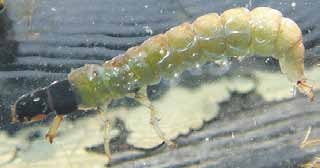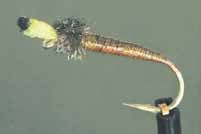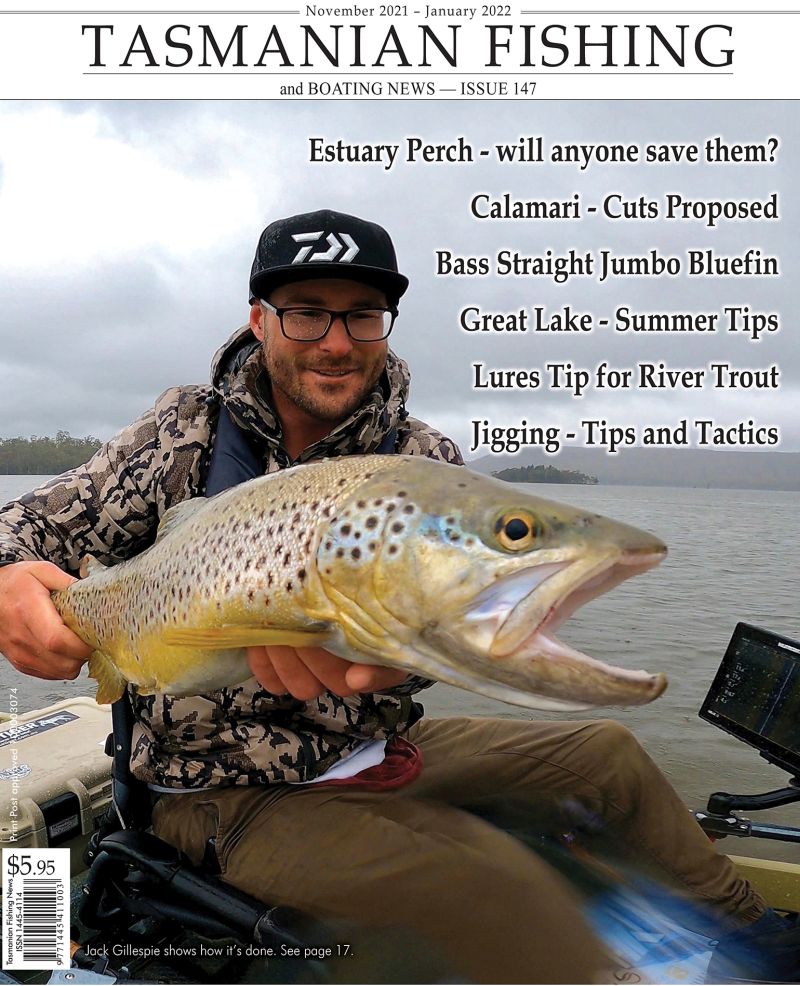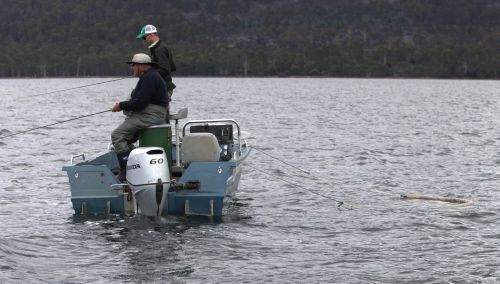 |
| Free living Caddis larva Family Hydrobiosidae) |
The Peeping Stick Caddis
Presented from Issue 117, August 2015
Caddis larva are very high on trouts’ diet. They come in two forms, those that build portable homes (Stick Caddis) and free living. All caddis larva have a hardened section near and including the head, whilst the bodies are soft and range in colour from off white through to a dirty yellow and green in a variety of shades. They also have claws to cling onto the inside of their portable case. Caddis can be found in water from fast flowing streams to marshlands and lakes. Case building caddis use leaves, sticks, reeds or spun silk as a home. These are generally found in slow moving or still waters: others use sand or very small stones and these are normally found in streams.
The importance of caddis as a food form cannot be underestimated; early research by A Dunbavin Butcher M.Sc. showed in The Freshwater Fish of Victoria and Their Food, 1950 that caddis represented around 40% for rainbow and around 30% food for brown trout. In many waters these figures would be higher for brown trout. Stick (case) caddis range in size from around 10mm up to 20mm and have a range of preferred material that they build their cases from.
Caddis WILL be in the water you are fishing, so get down and have a look. Let the water settle in the shallows and you will see them slowly swimming around. Check out their size and colour to determine the best size and the best colour for your artificial. Fishing with Stick Caddis is not new. Dick Wigram led the field during his day, closely followed by J M Gillies but the pattern that stood out for better than thirty years was Wigram’s. It also created many mutations. Dick Wigram wrote on stick caddis in his book, “The Uncertain Trout”, published in 1951.
His studies included an autopsy taken over the season 1945-46 and the stomach contents were recorded over an eight month period: It shows:
September: Meander River - Male 2lb., 31 caddis and two frogs
October: North Esk River - Male 1 1/2 pounds, 106 caddis
November: South Esk River - Female 2 1/4 pounds, 27 caddis, 1 stone fly
December: Lake River - Female 2 1/4 pounds, 90 caddis, 1 dragonfly, 5 mayfly
January: Meander River - Female 2 pounds, 31 caddis, 14 beetles, 2 mayfly
February: Macquarie River - Female 3 pounds, 130 caddis, 1 dragonfly larva, 4 grasshoppers
March: Brumbys Creek - Male 1 pound, 9 caddis, 3 mayfly, 5 beetles
April: Lake River - Female 2 1/4 pounds, 37 caddis, 4 beetles, 1 shrimp
This shows the importance of the stick caddis as a major food source. It should also be noted that, apart from the Snowflake Caddis, Wigram rarely talks in depth in any of his works about adult flying Caddis.
He also details the dressing for his Stick Caddis: There are many methods by which a reasonable copy of the Caddis case or stick can be made, but I have found that the following is the most effective: Hook, No. 1 or 2 (new scale), long shank. The body is made as follows:- Fasten to the hook with black tying silk a piece of the centre quill from the thick end of a rooster’s neck feather - allowing a quarter of an inch to extend past the bend of the hook, and leaving one-eighth of an inch clear at the eye. Tie in at eye a short length of raffia dyed brownish olive green. Build up the body with this raffia, thicker at the eye end of the hook, and covering also the protruding piece of quill. Finish raffia at eye and cut off waste. Tie in one turn of a short dark brown or black hackle and form a good sized head with the black tying silk. The whole fly from eye to tail end should be just under three quarters of an inch long.
Peeping Stick Caddis as adapted by Mick Hall
The best pattern I have seen was shown to me many years ago, but unfortunately his name is lost to me. Using a strand of peacock stem for the body was new and very innovative; I was truly impressed. The pattern is a follows.
 Peeping Stick Caddis, as tied by Mick Hall
Peeping Stick Caddis, as tied by Mick Hall
Hook: Mustad
R72. Size: 10-8
Body: Stripped peacock stem w o u n d o v e r dubbing any colour and finally dyed with a dark green marking pen with dark brown over
Head/legs: Peacock Herl
Grub: Chartreuse synthetic knitting yarn and burnt at the end to create the grub’s head.
Note: On the original as shown to me, the Peacock stem had been dyed to a similar colour as shown. It was the use of this case material that caught my attention. The peeping head had been around for some time but I must reiterate, this was new and very creative.
 Small Peeping stick caddis as designed by Mick Hall As designed by Mick Hall to imitate the small Silk-cased Caddis
Small Peeping stick caddis as designed by Mick Hall As designed by Mick Hall to imitate the small Silk-cased Caddis
Hook: Mustad
R72. Size: 16-14
Body: Uni-Flex White and treated with marking pens as described above
Head/Legs: Peacock Herl
Grub: Chartreuse synthetic yarn and treated as above. Note: Uni-Flex is also known as Flex Floss and a heap of other names.
Mick Hall




